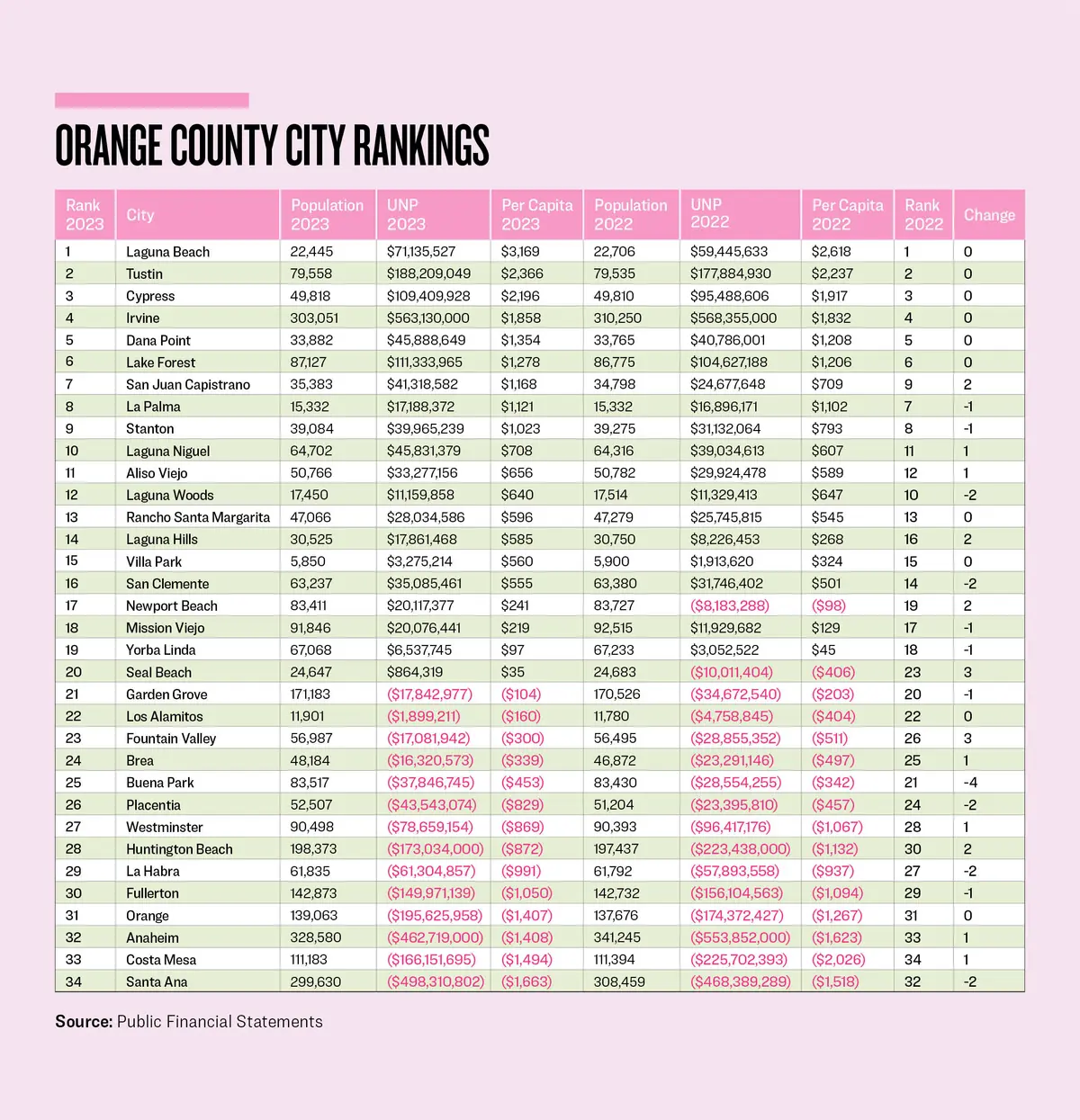Most OC Cities Financially Stable, While One Seeks Sales Tax Increase
Of Orange County’s 34 cities in Southern California, the six with the strongest balance sheets maintained their positions in the annual fiscal rankings for the year ending June 30, 2023. However, the other 28 cities were a little more interesting.
Overall, it was still a good year, with only one out of five seeing their financial situation get worse, while nearly four out of five improved.
The cities are ranked by their unrestricted net position (found in their annual comprehensive financial reports, or ACFRs) divided by the population, providing a useful tool for demonstrating a city’s fiscal health. A positive balance sheet is black, while a negative one is red.

A decreasing unrestricted net position of less than 1 percent did not hurt Irvine’s standing. Laguna Woods saw a 1.5 percent decline, causing it to drop two positions and allowing the cities of Laguna Hills and Aliso Viejo to move up one place each.
Buena Park saw expenditures exceed revenues by $7.8 million, explaining the bulk of its $9.3 million increase in its unrestricted net deficit. But it was significant enough to drop this tourism-focused city four positions.
Placentia had expenditures in excess of revenues of $4.2 million and construction-in-progress of $16.9 million, explaining the $20.1 million increase to its unrestricted net position and its dropping two positions.
La Habra’s expenditures in excess of revenues were only $1.2 million, but its unrestricted net deficit grew by $3.4 million, thanks mostly to increasing pension liabilities on its balance sheet. It dropped 2 places. It was in 21st place in 2017 and continues its decline in the rankings, now in the 29th position.
The city of Orange increased its unrestricted net deficit by $21.3 million. Its expenditures in excess of revenues were only $2 million, but increasing restricted assets for special projects and programs by $19 million explains the difference. Former Orange City Councilman, and current Chair of the Orange County Republican Party, Fred Whitaker, recently announced that the city added 50 additional staff members over the last three years. It would seem like some downsizing is in order. Instead, the city council majority recently voted to put a sales tax measure on the November ballot.
Santa Ana saw its revenues exceed expenditures by $31.7 million, but its unrestricted net deficit grew by $30 million. Increasing restricted assets by $10.8 million explains a portion of it, but an increase in pension debt of $39.9 explains most of the rest. Higher pension debts occur when employee salaries are increased. The Santa Ana City Council recently voted to give $27 million in pay raises over the next three-and-one-half years to its public safety employees. And it put a pay raise for themselves on the city’s November ballot.
Both actions by the Santa Ana City Council appear to be questionable for a city that dropped two positions, now holding last place, moving Costa Mesa and Anaheim up one position each. Both of these cities had a very good year, improving their unrestricted net deficits by $91.1 million and $59.6 million respectively, each moving up one position. Anaheim enjoyed revenues in excess of expenditures of $145.2 million, indicating the pent-up demand resulting from the overly lengthy coronavirus lockdown. Meanwhile, Costa Mesa reduced its expenditures by $23.6 million and saw its revenues increase by $35.7 million.
Laguna Hills was able to more than double its unrestricted net position, moving up two places. San Clemente, Mission Viejo, Yorba Linda, Garden Grove, and Fullerton had positive years, but still dropped in the rankings. That’s because cities like Laguna Hills, Newport Beach, Seal Beach, and Huntington Beach did a better job, per capita, in improving their unrestricted net positions.
Fountain Valley’s unrestricted net deficit improved by $11.7 million, jumping it up four places. Brea, a city that was once at the bottom of the rankings, improved its unrestricted net deficit by $7 million.
A big story is one of housekeeping, thanks to how long it takes certain cities to complete their annual audits by an independent Certified Public Accountancy firm. By Memorial Day, two cities still had not posted their ACFRs. And last year the rankings for 2022 were published on June 1. The city of San Juan Capistrano’s audit is dated June 25, 2024, less than a week before its next fiscal year closes. The city of Los Alamitos found their audit dated May 8, but did not post it on their website until last week.
Twenty-one of the cities met the December 31, 2023, deadline. Eight cities had their field work completed by March 28th. City number 31 was Placentia (4/30/24) and 32 was La Habra (5/16/24).
The 2023 audit report for last year’s last place winner, Laguna Beach, was dated March 29, 2024, which was an improvement over its prior year’s date of May 25, 2023.
In the end, all 34 of Orange County’s cities issued their 2023 ACFRs before the state of California, which may release its audit sometime next March. Hopefully all state and local governments can make this annual reporting requirement a priority, since it’s an important tool in providing transparency to their residents.
This article originally appeared in The Epoch Times
